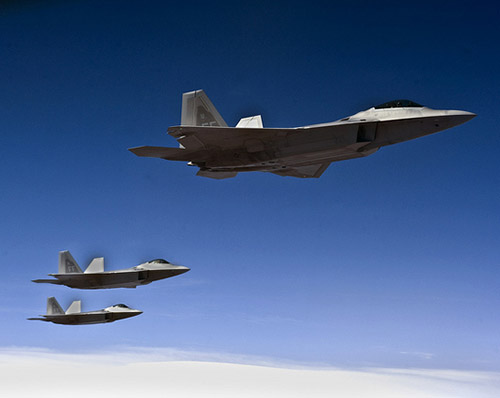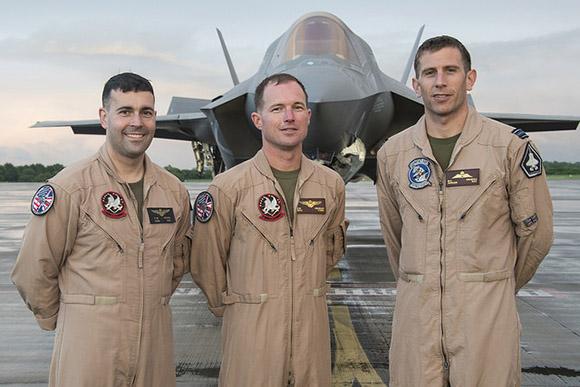These are special days for the promotion of the F-35 abroad. The fifth-generation tactical fighter has been in the UK for a few hours to participate in the Farnborough Air Royal International (photo opening).
The international debut of the F-35 was accompanied by the publication of a study signed by the Mitchell Institute regarding the capabilities of fifth-generation platforms against an X country (China or Russia). It would be the Air Force guidelines on how they intend to use the F-35 in the event of a conflict. The military, if a large-scale conflict broke out against a militarily modern country, excludes all fourth-generation aerial platforms from all first-line tactical planning. F-15 and F-16 therefore, even in their best performing versions, would not participate in the early stages of the conflict and not before having canceled the enemy defense network S300 / S400.
The imagined scenario is that of the 2026. The enemy's electronic disturbance capabilities are evident and such as to nullify the platforms prior to the fifth generation. The Pentagon relies on four systems: F-22 for air superiority, F-35 for tactical appearance, and B-2 and B-21 bombers. According to the military, only these four platforms could survive in a high-density environment and escape the next-generation enemy surface-to-air missiles.
Although China is never mentioned in the report, it is clear that Beijing is the enemy. There is talk of a "key region abroad", where there would be only a regional super-base, identified in Australia. However, the same concepts can also be applied to a war with Russia.
The Pentagon would deploy its air component, in small units, throughout the Pacific. In a war with China, the Air Force estimates the loss of regional hubs already in the earliest stages of the conflict. The capabilities of the F-35 are again taken up to underline the tactical advantage of the platforms, able to operate even from improvised structures. The fifth generation fighters, thanks to the integrated technology, will be able to operate with impunity without any type of ground support.

F-15 and F-16 (photo) will always remain in the rear as force multipliers (The package, nicknamed "F-15 2040C", would allow the Eagle to double the number of missiles transported). The study does not refer to their use as flying arsenals, but this tactical mutation is already in place, although currently reserved for bombers. The proposed solution of the Air Force is "the flying arsenal" which is based on a platform, probably it will be the B-52, able to transport dozens of missiles and precision bombs from the rear. An idea that the Air Force borrowed from the Navy, which converted four Ohio-class ballistic submarines to transport 154 cruise missiles Tomahawk instead of 24 Trident. It is clear that the Air Force relies on fifth generation platforms, but it seems more a dialectical exercise than a real operational plan. Numbers in hand, the Pentagon certainly cannot hope to protect sensitive areas of the planet and at the same time be able to win a war with China or Russia with only 60 / 70 Raptor (123 converted to combat, but we must consider the other theaters and fighters in maintenance).
The study supports the new Air Force doctrine at 360 degrees, which clearly differs from the Russian one. For the US military the close combat is now out of fashion, while it will be the best technology implemented in the platforms to declare victory in the contexts of the future. In the new doctrine, the fifth-generation fighter would be the winner of the discovery beyond the visual range thanks to the latest avionics. Once the threat has been identified, the fighter connected to the "flying arsenal" would transfer the pointing information.

The Air Force pushes for online "integrated combat forces" that can perform a variety of tasks in one mission. Planes stealth, which would no longer have the need to "stain" the profile, would continue to coordinate multiple attacks from the flying arsenals operating in the rear.
Do not think so Russians and Chinese who consider the dogfight as an essential prerogative of the fifth generation fighter. On several occasions, the study shows the characteristics of low observability, but this should be a real fact in the presence of a clean profile. One of the main limitations of the low observability configuration is determined by the internal load of the latest generation platforms. The ability to internally transport the weapon systems is an essential prerogative for a profile stealth clean. The internal capacity of an F-35, with all the good intentions one can have and try for the JSF, is not hunting from air superiority. And in fact it is not, as an exclusively tactical platform. The problem is that the F-22 (photo on the right), for example, only carries six BVR missiles, the F-35 only four.
The F-35 seen just like a Next Generation Jammers? The objective of the study is precisely to stimulate a discussion on the optimization of fifth-generation platforms on the battlefield in concert with all other American and allied assets.
(photo: Lockheed Martin / US DoD)












